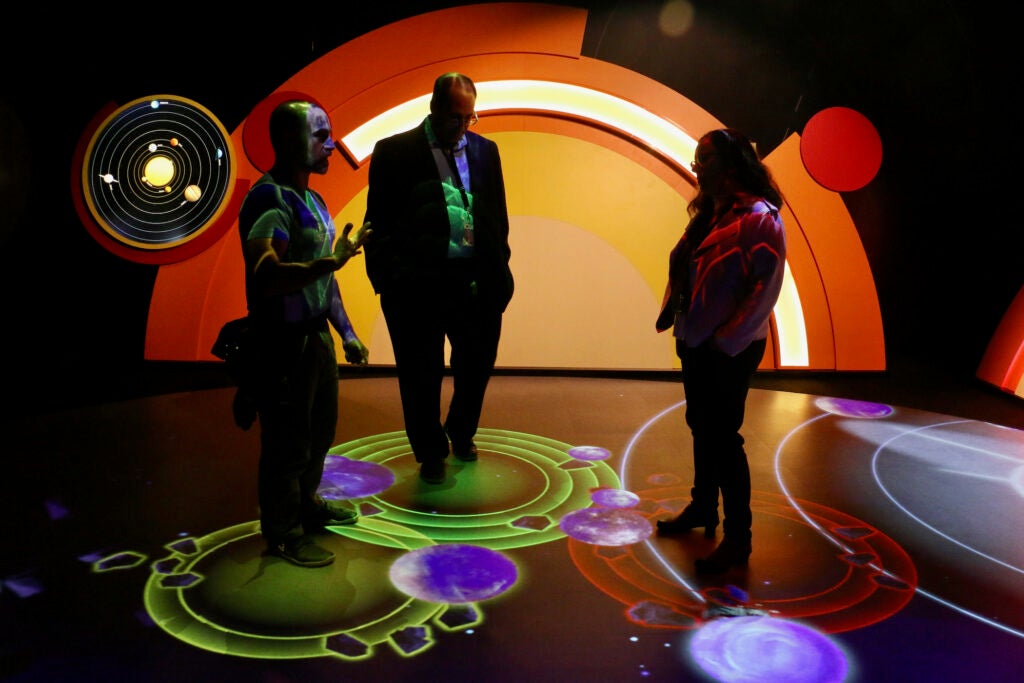From Philly and the Pa. suburbs to South Jersey and Delaware, what would you like WHYY News to cover? Let us know!
Derek Pitts couldn’t be happier.
The astronomer and spokesperson for the Franklin Institute helped announce its newly expanded and updated outer space exhibition, Wonderous Space. It takes up two floors of the Institute’s building on the Parkway, sandwiched between the Fels Planetarium on the ground floor and the Holt and Miller Observatory on the roof.
“I’m so excited that there are now astronomy-related exhibits on all four floors,” said Pitts. “Perfect for me.”
-
WHYY thanks our sponsors — become a WHYY sponsor

With the support of Boeing, the $8.5 million renovation is the first phase of a building-wide overhaul of the Institute’s science exhibitions. Over the next several years, 12 subject exhibitions will be reduced to six: space, the human body, earth science, computer science, the built environment, and machines and robots.
The expanded Wondrous Space, encompassing 7,500 square feet, has absorbed what used to be the electricity exhibition space.
“The six exhibits will be double in size and double in scope. They’ll go deeper than we’ve been in these topics,” said Franklin Institute CEO Larry Dubinski. “There’s so much interdisciplinary work in science. What you’ll see in an exhibit like this is not just physics but everything from engineering, material science, and bioscience.”

The first floor of Wondrous Space is dark and mysterious, with low lights punctuated by illuminated interactives demonstrating powerful forces in outer space that you can’t see with the naked eye: radiation waves, gravity, and orbits.
In the first room, visitors can punch buttons in pulse patterns that mimic the frequencies of celestial waves. If they do it correctly, they are rewarded with a sudden burst of light and sound.
To experience very high-energy waves too rapid to replicate by hand, like gamma rays, visitors can rest their palm on a surface that vibrates at high frequencies.
“When you get to actually feel sound waves and stuff like that, those are the things that help connect the dots for a lot of people,” said Brandon Burroughs, a Boeing employee who served on the advisory committee for Wondrous Space. “That connection can sometimes be lost when you have to sit and read two paragraphs about something that could be explained by just feeling it. It gives you a holistic experience.”

Each room on the first floor has its own sound design that echoes and accentuates the sounds generated by the exhibitions. The room that explains galaxies and what they are made of, has circular seating pods and part of the floor is tilted to encourage kids of all ages to lie on the floor and look at projections on the ceiling.
-
WHYY thanks our sponsors — become a WHYY sponsor
Information about the exhibition is available, but designer Dan Picard, of the Orland-based MDSK agency, did not include many instructions about what visitors are meant to do in the space. He wanted to create a “vibe” where young people can explore and discover.
“We wanted to do some experiences that were on the ground, above you, around you to spark that curiosity of looking up in the night sky,” Picard said. “With the aid of James Webb space telescope images, we can utilize that in some of these experiences to give you that really cool, celestial vibing-out space.”
The best selling item in the Franklin Institute gift shop, year after year, is freeze-dried ice cream. For many young visitors, space means astronauts. Kids want to eat what astronauts eat.
Now, they can test their space explorer nutrition chops on the second floor, by planting crops on Mars. A digital kiosk makes a game out of selecting plants for their nutritional value and hardiness, and then see how well their selections are able to sustain life on another planet.
It’s one of many interactive kiosks on the second floor of Wondrous Space that turn space colonization into a game. Digitally assemble a rocket and see if it will take off. Build a digital suit and see if it has what it takes to protect you in space. See if you can pilot a rover over the rocky surface of Mars.
Space is not just astronauts. Wondrous Space wants to introduce young people into professions associated with space travel, which never leave the ground. The exhibit features life-size interactive screens that profile people who work in the aeronautical industry, including engineers, business managers, event planners, even fashion designers.

Salam Abualhayjaa grew up in Jordan with an interest in fashion, and now works as a mechanical engineer designing space suits. In her recorded interview, she said she is working on space suits designed for women.
“But it’s not for space, it’s for Earth,” she said. “It’s a kind of training: all the vitals, the sensors, and life support, and how to deal with such systems.”
Amanda Ireland grew up in the Philadelphia area and attended Drexel University. She now works as a launch operations engineer for Boeing’s Starliner program, which rockets astronauts and scientists to the International Space Station.
When asked to be on the Wondrous Space’s advisory committee, she jumped at the chance because as a kid she used to come to the Franklin Institute’s previous space exhibition.
“While it was very cool and science-y, I didn’t quite see myself in it,” she said. “Coming back and getting to work on this, I want to make sure students could see themselves in it. It’s more than just something really, really smart people do. It’s something that everybody can do if they’re interested. There’s a place in different roles for every different kind of person.”
WHYY is your source for fact-based, in-depth journalism and information. As a nonprofit organization, we rely on financial support from readers like you. Please give today.






